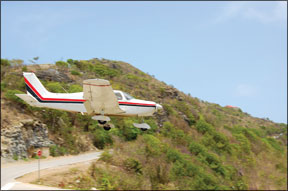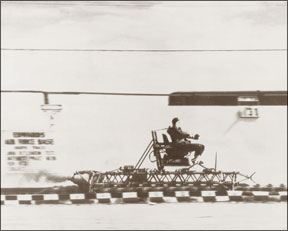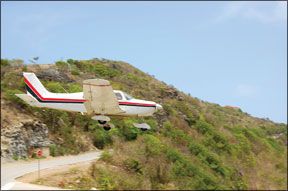One of the more unpleasant realities of personally flown aircraft is that ones exposure to the risk of coming to a stop in a fashion other than intended is higher than we care to admit. While many of us fly our entire careers without so much as a scratched airplane or an engine hiccup, others are not so fortunate,
Those of us with an IQ above room temperature accept there is a true risk of being involved in a crash. Once the premise is accepted, the question becomes what to do about it. One answer is to think about it beforehand and act accordingly,

288
especially when it comes to considering occupant protection, developing a personal checklist and preparing for when something ugly happens.
Practicing Self Restraint
Years of research and feedback from the school of hard knocks has shown time and time again that the single most important thing we can do to protect ourselves in the event of a quick stop is to wear all of the available restraining systems in whatever seat we occupy. There has been full-scale human impact research going on since World War II, and it is absolutely consistent in its results: An unrestrained occupant has a lousy chance of surviving any kind of crash impact.
Even low-speed collisions generate G loads in the double digits, and no human being in the world is strong enough to “brace” for those loads (nor prescient enough to predict their precise direction even if it were possible).
A seatbelt is the first line of defense; it keeps the occupant more or less in the seat and stops a major killer in accidents-that of being thrown out of the vehicle. (And, as comedian Bill Cosby once noted, it helps the ambulance driver find you.) While folklore is full of anecdotes about people who survived because they were “thrown clear,” inquiry into those stories has shown that virtually every one is a myth. A human isnt designed to hit the ground, a tree or wall going 30 miles per hour, much less whistling along at 70. The degree of pulverization of bones, soft tissue and internal organs when that occurs is the stuff of which pathology textbooks is made.
While aircraft construction techniques for impact attenuation have been steadily improving since the 1960s, even fairly old airplanes are surprisingly crashworthy. The structure will absorb a great deal of the energy of an impact as it crushes, and every bit of it absorbed wont be transmitted to the occupants as long as there is still in a seat. (We recognize the jury is still out on a lot of the light sport and ultralights as to whether their engineers were ever exposed to or have applied the hard-earned lessons of crash dynamics in airplane design; nevertheless, the first line of crash survival defense in any airplane is the restraint system.)
The seat belts shortcoming is it restrains only the hips, allowing the rest of the body to keep moving forward and jackknife. No one is strong enough to prevent it. If there were a lot of room in front of the seat it would be no big deal. But a blunt truth is that general aviation airplanes have dinky cabins and there is little “flail” room for the human body. So, when things stop abruptly, your head smacks the instrument panel and your chest gets impaled by the control yoke (side sticks are a huge benefit in crash protection).
But, wait, theres more: The Piper J-3, Aeronca Champ, Ercoupe and airplanes of that vintage have a horrible rate of serious injury and death in fairly slow-speed accidents. Unrestrained occupants can easily hit their heads on either the panel or the seat frame of the front seat, and either die or are dazed enough they do not get out of the airplane before it burns. And those airplanes burn like torches in low-speed crashes because they have a fuel tank in the worst possible location in an airplane: right in front of the people, and just behind the engine. On impact the engine stops, the airplane continues forward and crushes, which is a good thing from the point of view of reducing loads on the people, but a bad thing because in that crush zone is the fuel tank. It is breached and dumps fuel on the engine and into the cabin. And thats bad.
Harnessed
One solution (at least partially) is the shoulder harness. Keeping the occupant more or less in the seat and in the available “flail” area means there is less chance of slamming into some part of the airplane structure, which is a very, very good thing. It also means that when things come to a stop the person is more likely to be able to get out of the airplane before it burns. One shoulder strap is good; two are better, since as there is less risk of rotating out of the single strap during the crash sequence. With more crashworthy fuel systems being developed by the 1950s (fuel in the wings, often protected between the spars, and fuel lines routed along the strongest portion of the aircraft structure), the rate of post-crash fires went down. If a fire developed, there was more time before it started or grew so serious that occupants could not get away from the airplane. The shoulder harness buys escape time because it helps keep the occupants conscious.
Years of looking at aircraft accidents with too many unnecessary deaths because available restraint systems were not worn has caused us to form some very strong opinions on this subject, so we will express them frankly: With the restraint system being the single most effective method of self protection in a crash, any pilot who does not wear all of the available restraint system is as lacking in common sense as a motorcyclist without a helmet and, in our opinion, may not have the requisite basic judgment to be a pilot. Further, it is up to the pilot to assure that the passengers wear the restraint systems, every strap, or risk being found negligent in the event of being sued by the estate of that passenger following a crash.
Shoulder harnesses can be retrofitted to many older airplanes (see the sidebar at left). For all single-engine Cessnas built after World War II, as well as the Skymaster line, shoulder harnesses were an option at every seat. The hard points are in the airplanes and installing shoulder harnesses in those airplanes takes less than 10 minutes per seat. If you are an aircraft owner and care about your family and your other passengers, its a no-brainer safety investment. Retrofitting other types of airplanes may or may not be possible. If not, carrying something that an occupant can use as padding in front of his or her face if an accident is imminent is a wise idea (plus its nice to have a few pillows in the airplane).
Coming To A Stop
While it sounds so elementary as to be foolish to say, it is the quick stop that kills. Anything you can do to maximize the distance and time from when the airplane first touches the ground to when it comes to a stop increases the chances of survival. The deceleration forces experienced in a crash landing are exponential, not linear, in nature. In other words, reducing your speed by half reduces the energy to be dissipated by a factor of four.
Whatever you can do to slow the airplane down before it hits something that brings it to an abrupt halt benefits you by the square of the speed reduction. This means

288
if you can select where you are going to put the airplane, try to pick an area where you will have as much room to decelerate on the ground as possible. And, believe it or not, a paved surface is better than dirt or grass, especially if you mess up and stall the airplane and drop it in.
Pavement will translate much of the vertical load into horizontal load, and the airplane will slide rather than stop quickly. Dirt or grass may very well give a bit, creating a crater, and then stop the airplane right there. NASA did full scale crash tests on dirt and on concrete and found that given the same velocity and impact angle with the ground, the chances of surviving were far, far better on concrete.
The need to dissipate energy also means you should never stall the airplane prior to touchdown. The vertical load, especially if the gear is up, may not be attenuated by the aircraft structure and can cause serious spinal injuries (which is why helicopter crash victims have extremely high rates of spinal compression fractures). If the ground gives and forms a crater, the airplane may stop abruptly, putting unsurvivable G loads on the occupants.
Prepping The cabin
Block the doors or canopy open just slightly before touchdown. Its hard to open a door when the airframe is bent. Be ready to kick out a window-you can do it, Plexiglass is not all that hard to break.
Turn off the master, mags and fuel shortly prior to touchdown. The idea is to reduce the chance of post-crash fire or its intensity. Some very serious post-crash fires have been started by the electrical system, with zero fuel involvement, and aluminum burns almost pyrotechnically once it gets going, so shut everything off.
Have your passengers assume the position. Lean forward into the shoulder harnesses to take out the slack. If there is no harness, put a pillow or coat in front of each persons face, and have them lean against the panel or the seat back in front of them so they dont slam into those items. (Make sure you can still flare the airplane-human bodies really dont like control yokes.)
Land right side up. It sounds trivial, but pilots experiencing an engine-failure accidents in a twin too often try to get performance out of the remaining engine that wasnt built into the airplane, get below VMC and roll over prior to crashing. There is almost no occupant protection in an inverted crash; there is a lot if the airplane is right side up.
Do not stall the airplane prior to touchdown. Yes, we said it before, we mean it. Fly the airplane to touchdown as slowly as possible, keeping it under control. A stall, by definition, means the airplane is not under control.
Which leads to the hoary aviation axiom long credited to Connie Edwards of Texas (and to R.A. “Bob” Hoover-Ed.)-fly the airplane all the way into the crash. Keep trying to make the airplane go where you want it to go; keep aiming for something soft and cheap.
Even if you wipe out the gear (or land gear up), the aerodynamic controls may take you where you want to go. If you hit a wing on something and the airplane swerves, stand on the rudder and brake to try and get it traveling in the direction you want to go. Try to make sure the airplane is facing the direction it is traveling: There is a lot of structure ahead of you to absorb loads; there is much less on either side of you. Use the brakes. Use them hard in tricycle-gear airplanes, to the point of sliding the tires and then back off just a smidgen; in tailwheel airplanes, brake as hard as you can using your judgment based on your knowledge of the airplane and the surface to keep from flipping over.
Stopping
Wait until the airplane comes to an absolutely full stop before releasing the restraint system. At 20 mph, it may feel as if you are going slowly, but hitting something at 20 mph after youve popped the restraint release may be the last mistake you ever make.
The human body, in good shape, can tolerate about 25G for a short period of time. (The much-publicized rocket sled tests by Col. John Stapp in the 1950s that generated data indicating he withstood 40G could never be reproduced. It appears that the G-load onset rate allowed him to go into his very sophisticated belt system gently to “preload” it before he was subjected to 40G-when the occupant smacks into the belts 25G appears to be near the limit). Many general aviation airplanes will protect an occupant in a short duration, 25G, straight-ahead impact if the restraint system is worn. Thats a great deal of force; so a little planning by the pilot can allow the design of the airplane to help keep everyone inside alive in a pretty nasty crash.
Miracles?
We hear the TV talking heads speak of “miracle” survivals when showing pictures of badly mangled airplanes where the occupants emerged with minor injuries. We who fly know there were no miracles involved, just good design, engineering for impact attenuation, and pilots who insisted that everyone wear their restraint systems, and then flew the airplane until it was completely stopped.
Rick Durden is a practicing aviation attorney and type-rated ATP/CFI with more than 7000 hours.




